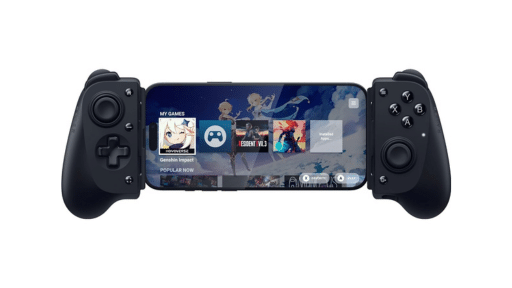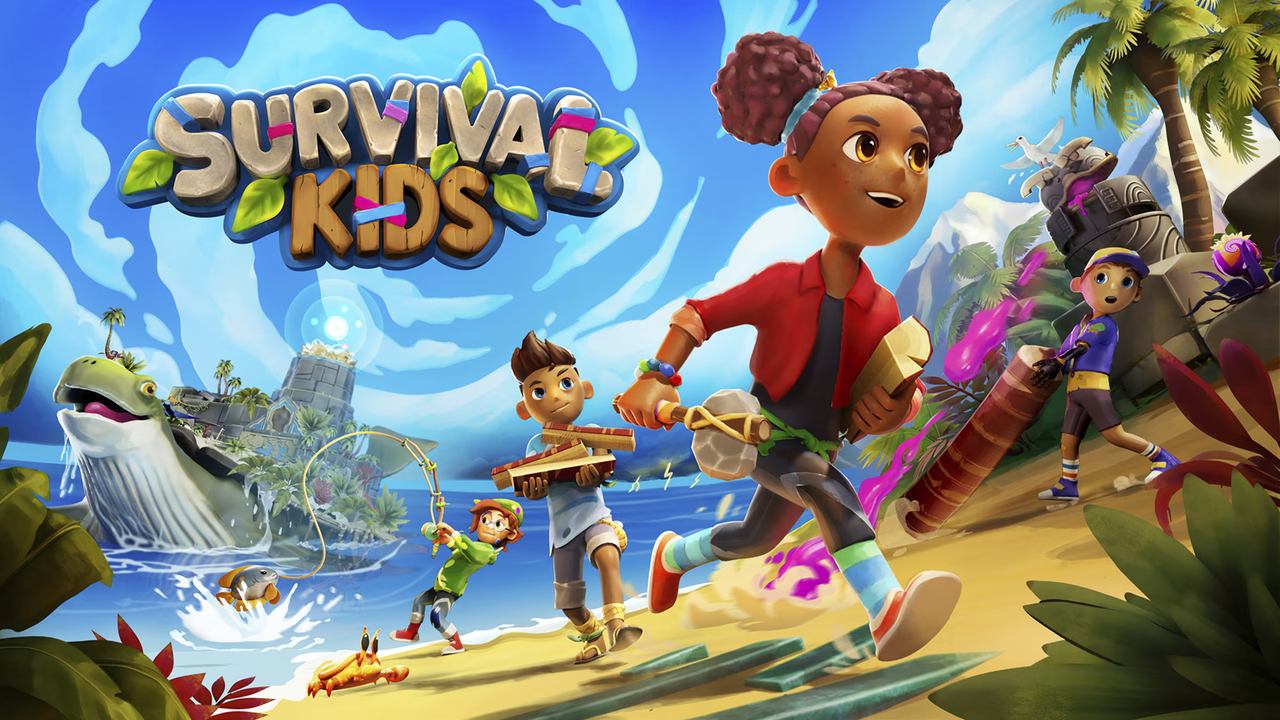
Survival Kids returns with a new look and a new focus. Originally released in 1999 on the Game Boy, the game was known for its tough survival mechanics and nonlinear structure. This new version, developed by Unity and published by Konami, trades that challenge for something more accessible. It’s now a puzzle-focused co-op game with basic interactions and a slower pace, launching as part of the Nintendo Switch 2 lineup.
Instead of exploring one big island, Survival Kids takes you across a bunch of smaller ones. Each level puts you on the back of a giant turtle, with light platforming, crafting, and co-op tasks. You can play by yourself or with up to three others using local splitscreen, online, or GameShare. No matter how you play, the goal stays simple. You gather materials, make tools, solve a few puzzles, and move on to the next island.
It’s a game designed around approachability. There are no game overs, no hunger meters to manage, and no real punishment for failure. That makes it a smooth starting point for newcomers, but it also means those looking for a tougher survival experience might not find much to latch onto.
Let’s take a closer look at how Survival Kids handles its island-hopping adventure and whether its simple approach holds up.
Island to Island
Survival Kids doesn’t focus much on story. Instead, it drops you into short, island-based levels where the goal stays the same. You start shipwrecked, figure out what’s broken, and find a way to leave. Sometimes that means fixing an elevator to reach a higher area. Other times, you’re repairing a boat to move on to the next turtle island. Either way, the objective is clear and the structure stays consistent.
Progression feels like a checklist. You collect parts, build makeshift paths, and handle small construction tasks to push forward. The Harmony Stone sits at the centre of each island. It marks your camp, moves with you as you progress, and becomes the final item you carry to your exit point. That could be a repaired ship or a working elevator. Once you escape, it leads directly to the next turtle-shaped island.
Each stage introduces a few new gameplay mechanics, but the overall structure remains consistent throughout. You’ll run into the same kinds of obstacles like gaps, blocked paths, or missing parts and handle them using the same basic tools. Some variety comes from blueprints that unlock gear like gliders or fans. There are also collectibles like hidden glyphs and Treasure Stones, which tie into the game’s star system. Finishing quickly and finding everything earns you up to three stars per island.
To unlock the final stage, you need a set number of stars. That adds a light replay element, though redoing earlier islands can feel repetitive. The pacing stays steady, and the game keeps its approach simple and consistent.
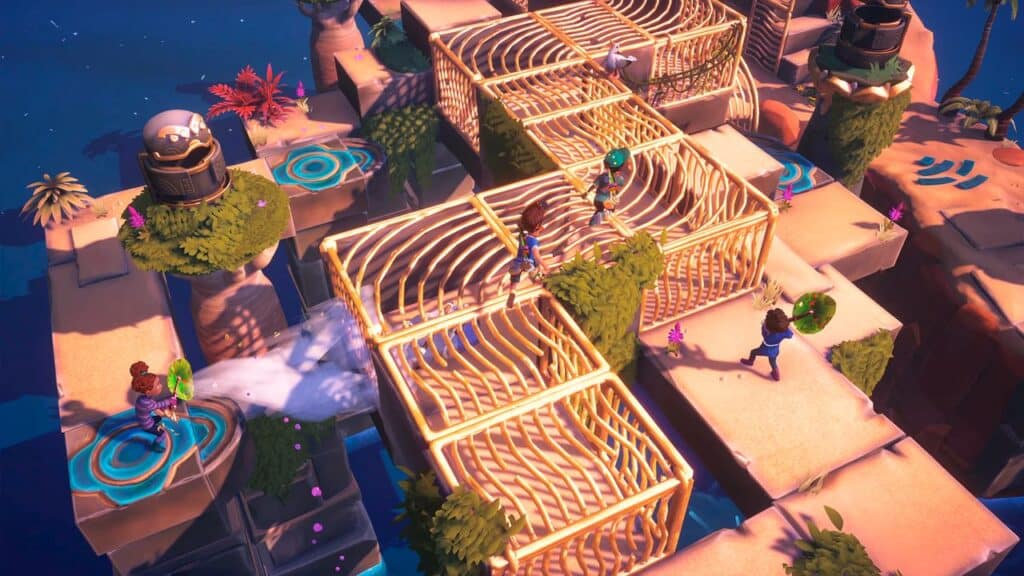
Gather, Build, Repeat
The gameplay in Survival Kids revolves around collecting materials, crafting tools, and solving small puzzles built around the environment. You’ll spend most of your time chopping trees, hauling objects, building bridges, and cooking food to restore stamina. The controls are straightforward. Pressing a button near an item snaps it into your hands, and you can only carry a few things at once. That limitation forces you to plan how and when you move materials across the island.
Most stages follow a predictable rhythm: explore, find what’s broken, and patch together a way forward. Sometimes that means crafting a glider to cross a canyon or using a fan to push parts into position. Other times, it’s just walking across a basic bridge and clearing a blocked path.
During one level, I ran into a broken elevator part that was wedged behind a rock. I had to gather wood, toss it across a gap into a crafting box, then carry the finished bridge piece back to the ledge to cross safely. It wasn’t hard, but it took just enough effort to feel satisfying. What helped most was the ability to grab and stack similar items quickly. Even playing by myself, it didn’t feel too slow.
You unlock new tools by finding blueprints scattered around the island. These open up new traversal options like fishing, climbing, or gliding. The stamina system plays a small role, but food is easy to find and keeps things moving. The tasks stay familiar from island to island. Whether that loop stays fun depends on how much you enjoy short, low-stress objectives.

Responsive Controls and Relaxed Flow
Survival Kids keeps things simple. The visuals aren’t flashy, but they get the job done. Each island has a basic layout with clear paths, soft colours, and objects that are easy to spot. Character designs are minimal, and the environments repeat often, but nothing gets in the way of your tasks. The soundtrack leans toward background noise. It fits the relaxed tone but doesn’t stand out.
Controls are one of the game’s strongest points. Movement is smooth, item interactions are fast, and crafting is reliable. Holding a button picks up items quickly, and snapping them into place feels consistent. Jumping is light and floaty, but the game rarely punishes missed landings.
Stamina still plays a light role here, but food is always nearby to keep things moving. You won’t fail if you run out—it just slows your progress until you cook something. The narrator gives you constant reminders about what to do next. While helpful at first, it can feel like too much guidance. You can turn the waypoint system off in the settings if you prefer figuring things out on your own.
Performance is mostly solid. Standard gameplay runs well, but GameShare mode lowers the frame rate to 30 and adds thick black borders around the screen. Local splitscreen and docked play are smoother and easier to follow.
Overall, the presentation supports the gameplay without getting in the way, even if it doesn’t leave a strong impression.
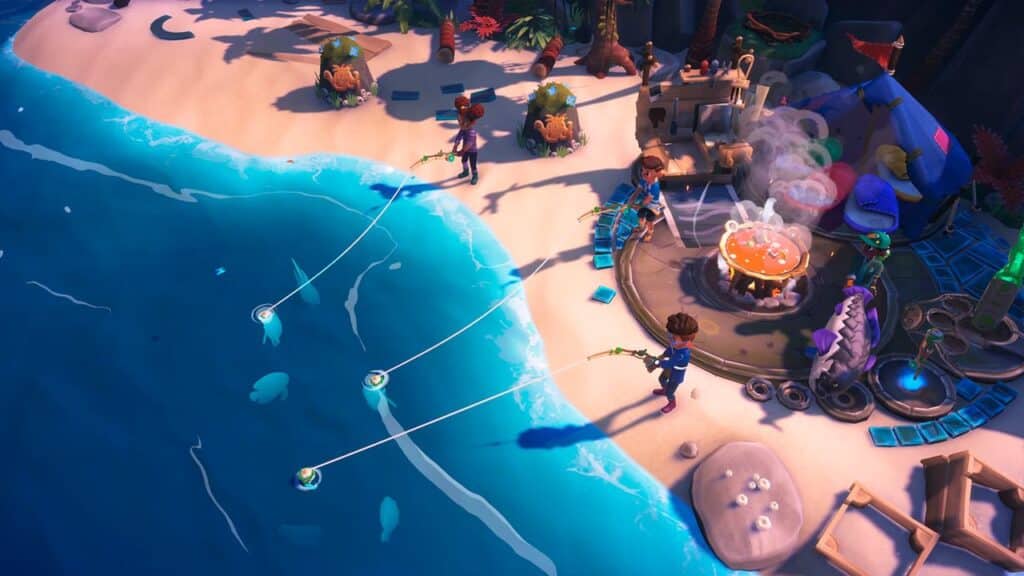
Multiplayer Works But It Has Limits
Survival Kids is clearly built with multiplayer in mind. You can play with up to four people using local splitscreen, online matchmaking, or Nintendo’s GameShare feature. Each method works, but they don’t all offer the same experience.
Local splitscreen is the most reliable option. It divides the screen vertically and runs smoothly whether you’re docked or handheld. Online co-op uses a simple lobby code system and works well if everyone has their own copy. If you want to save money, GameShare lets up to three other users join your game using just one copy, but with some trade-offs.
GameShare streams your session to nearby Switch systems, including the original console. This drops the frame rate to 30 and adds a thick black border around the screen. There’s also some input lag. It’s playable, but it’s not ideal for long sessions. That said, for families with multiple consoles, it’s a nice option to have.
Tasks scale based on team size, which encourages working together. Carrying materials as a group and solving puzzles side by side adds a bit of cooperation, but not every task needs multiple people.
The game works fine alone, but hauling materials takes longer without help. You’ll spend more time walking materials back and forth, especially in the later stages. The best experience comes from couch co-op. Working together on one screen avoids the drawbacks of GameShare and makes the pacing feel more balanced.
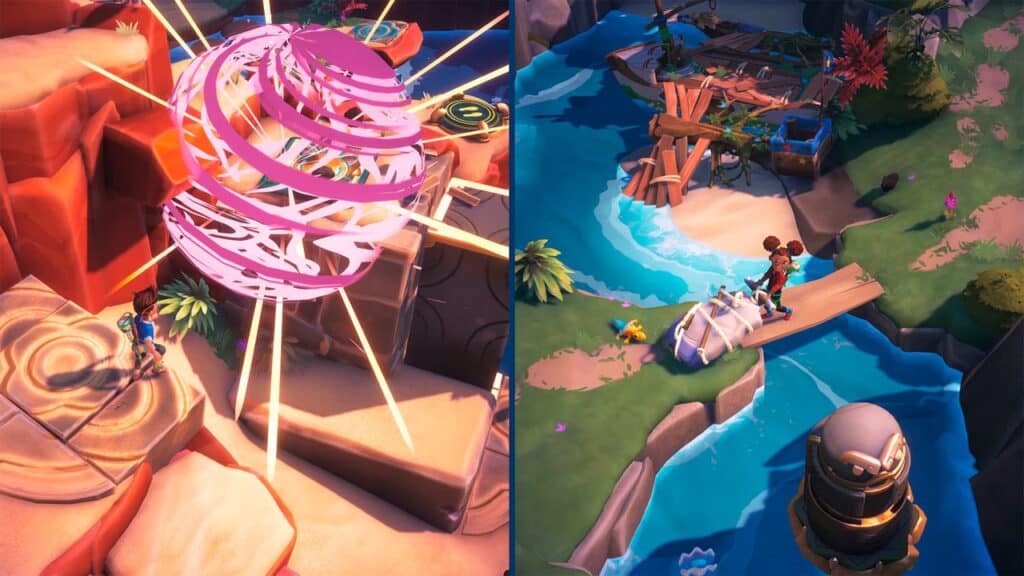
Survival Kids Is a Low-Stress Game That Knows Its Limits
Survival Kids sticks to a simple idea and doesn’t stray far from it. You carry out short tasks using simple tools to finish each island. It works well enough, especially if you’re looking for something low-key and easy to play with others. The slow pace, responsive controls, and clear objectives make it approachable right away.
The game doesn’t offer much challenge, and that’s intentional. You won’t lose progress if you make a mistake, and food is always nearby. Most of your time is spent moving objects, building tools, and figuring out basic puzzles. Blueprints add minor variety, but the overall format never really shifts.
Still, there’s something to be said for a game that doesn’t ask too much. I played through most of it by myself, switching to couch co-op near the end. The change made a big difference. Simple tasks felt quicker, and the later stages were more fun to solve together. Even when things slowed down, I appreciated how steady and consistent everything felt.
If you’re hoping for a tough survival challenge, you won’t find it here. But if you’re after a short, puzzle-focused experience you can play alone or with others, Survival Kids fills that role well. It might not hold your attention for long, but it’s a calm, cooperative break from heavier games.
Survival Kids

Summary
Survival Kids is a simple co-op puzzle game built around crafting, exploration, and short, low-pressure tasks. It’s approachable from the start, with no real fail states and intuitive controls. The structure repeats often, but steady pacing and flexible multiplayer options give it staying power for casual sessions. It’s a solid intro to survival-lite gameplay, especially for those new to the genre.
As always, remember to follow us on our social media platforms (e.g., Threads, X (Twitter), Bluesky, YouTube, and Facebook) to stay up-to-date with the latest news. This website contains affiliate links. We may receive a commission when you click on these links and make a purchase, at no extra cost to you. We are an independent site, and the opinions expressed here are our own.

